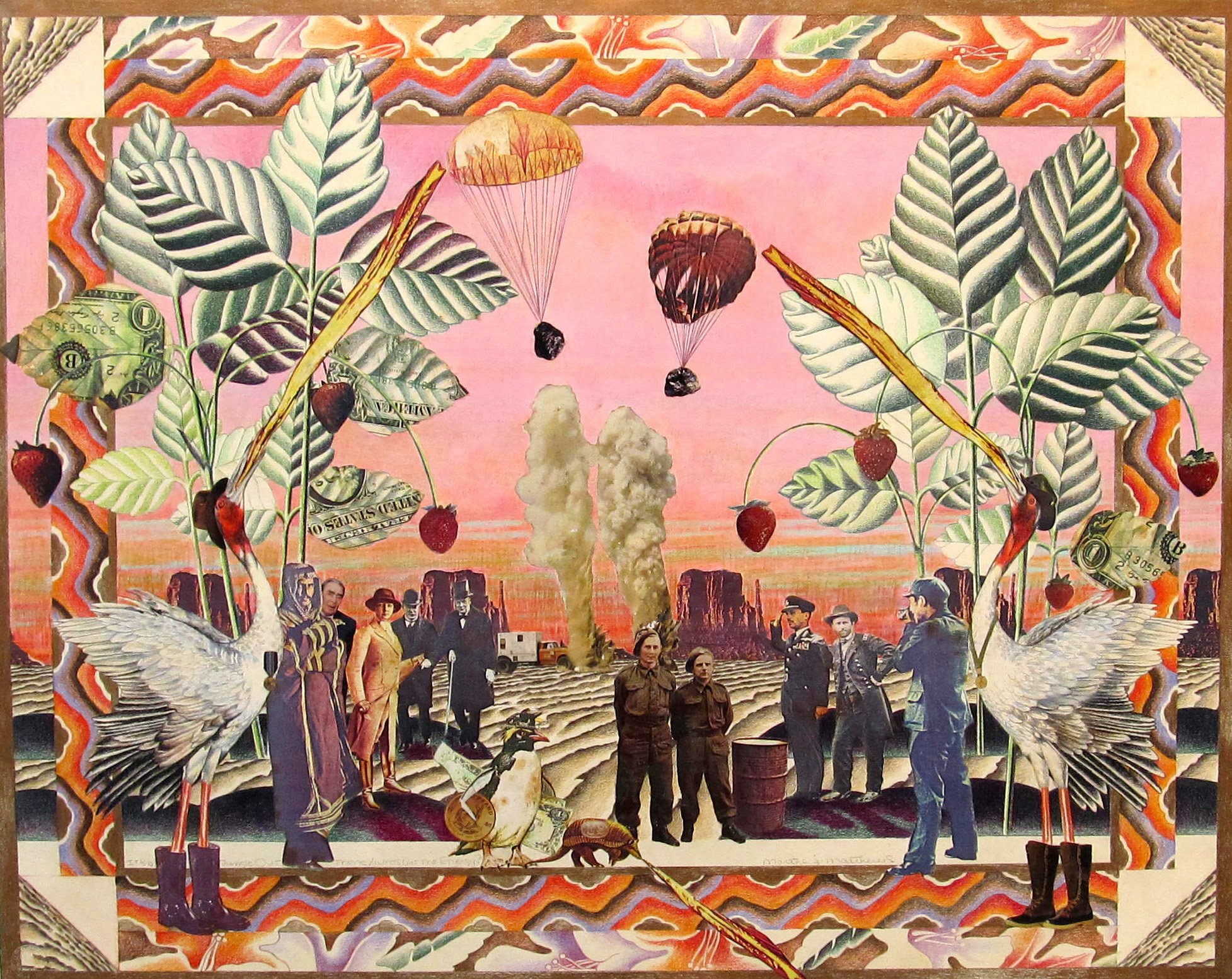Saving Martha
PROJECT
2018–present, ongoing
Camoflaged Blender, silkscreen 1973
S C H U E T T E / S T U D I O coordinates the Saving Martha Project whose mission is to preserve the print work of Martha Matthews (1935 – 2019) by documenting, and storing it in archival materials, working to get it accepted in appropriate institutional archives, and arranging exhibitions and preparing related historical documents. Begun in 2018, the project has moved 31 print editions with a total of approximately 350 prints from storage, catalogued all of them, and started the process of storing them in archival boxes with acid-free slip sheets. The archive also includes 6 unique mixed media/collaged drawings circa 1985 and silkscreen domestic objects like the Atomic Bomb potholder and Presidential fly-swatter series from the mid 70’s.
Colleagues and volunteers who have worked on the archive are Jessica Ballenger, Caroline Benkendorf, Kaytie Johnson, Carol Hobson, and Connie Janzen.
SASSY, an exhibition of this archive, was shown in 2019.
The San Diego History Center/SDHC has acquired ten prints, several of which are currently on display.
SDHC Collections Specialist Leilani Alantaga-Caithness has written an article In the Archives: The Saving Martha Project for the San Diego History Journal, Spring/Summer 2022/volume 68 numbers 1 & 2.
The Saving Martha Project is a model for other San Diego women who have bodies of work that lack recognition.
Juggling Act, silkscreen c. 1979
Juggling Act/Survival, silkscreen c. 1979
Kitschen Eroticism, silkscreen c. 1979
Careers for Women, lithograph 1974
Careers for Women 2, lithograph 1974
It’s a Jungle out There - Who’s Got the energy?
1984, ’85, ’86, ’87 . . .
MARTHA MATTHEWS
SASSY, an exhibition in Celebration of her Art and Spirit
May 4 through June 1, 2019 by appointment
This exhibition is part of the Saving Martha Project
To use everyday household objects, things thought of as trivia, to symbolize the human condition, has engaged my interest for some time . . . Colanders, drain stoppers, garlic presses, and tea balls have the same interest for me that a Henry Moore sculpture has for others.
SASSY includes prints from the 1970’s, mixed media works from the 80’s, and four watercolor studies from the 90’s. When I met Martha in the mid-70’s, she was a 40 year old San Diego State graduate student with feminist ideals, a smart sense of humor, and a graphic background (a 1956 degree from Rhode Island School of Design in illustration) that enabled her to make punchy prints about the ironies of domestic life. At this time in San Diego, Eleanor Antin and Martha Rossler, both teaching at UCSD, were working with some of the same concepts as Martha, but their reputations were secured on the East Coast. Martha is important because she represents a local/communitylevel sophistication that is underestimated or nonexistent in most discussions of contemporary art in San Diego.
Martha’s prints are mostly serigraphs which are more often used in commercial advertising. Hand-pulled silkscreens came into fine art prominence with Pop Art, especially Andy Warhol’s Marilyn series of 1962 a combination of hand-cut and photo techniques. Warhol’s Mao series is 1972-74 and Martha’s early prints including the Camouflaged Blender (1973) are from the same timeframe. Clearly she was influenced by Pop Art, but the feminist viewpoint is unique. Kaytie Johnson, the Visual Art Curator of the San Diego History Center uses the term radical domesticity for Martha’s work.
The exhibition includes the Drawer series, Juggling Acts, Careers for Women, and the Tea Ball series which “recorded the adventures of a kitchen gadget”. The Tea Balls were Martha’s SDSU Thesis project for which she received her Master of Arts in 1976 at age 41. As there are two formal elements in the prints, so are there two emotional elements that made me choose a tea ball as a stand in for the human condition, and as a form of expression of the humor and anger that colors my view of life.
Martha stopped making prints when she developed a severe reaction to the chemicals. Her mixed media work from the 80’s (they are not dated) was in response to the end of her ability to print and they echo her interests from the earlier prints in their use of political characters, the aggressive graphic borders from the Tea Ball series, the humor, and the introduction of landscape/natural elements. In the 1990’s Martha started working in acrylic and watercolor. The hand-drawn illustrations of the mixed media work had caused carpal tunnel syndrome. The paintings of caves and industrial landscapes were exhibited and received critical attention. Martha quit painting at the age of 75.
With the support of Martha and Jerry, I started my work on saving Martha’s prints in April of 2018. My friends Kaytie Johnson, Carol Hobson, Jessica Ballenger and Connie Janzen helped move 31 print editions with a total of approximately 350 prints from storage, and we have catalogued all of them, and are in the process of storing them in archival boxes with acid-free slip sheets. Caroline Shine Benkendorf, Martha’s friend has been invaluable in the preparation and installation of this exhibition.
The mission of the Saving Martha Project is to preserve Martha Matthews print work from the 1970’s (1973 – 1979) by documenting and storing it in archival materials, working to get it accepted in appropriate institutional archives, arranging exhibitions, and preparing related historical documents. Also the Saving Martha Project can be used as a model for other women who have bodies of work that lack recognition.
We are currently seeking funds for archival materials and consultant fees.
Lynn Schuette, May 3, 2019
Quotes from: The Tea Ball: Ironic and Decorative Images in Print
Martha Matthews, Master’s Thesis, San Diego State University, 1976











